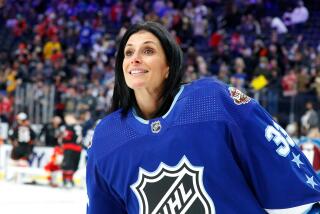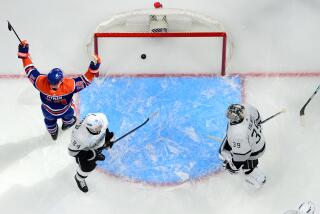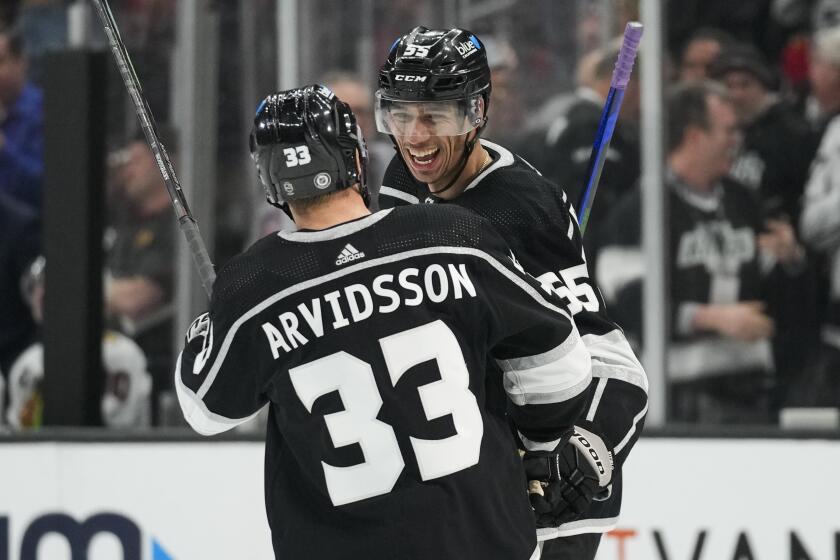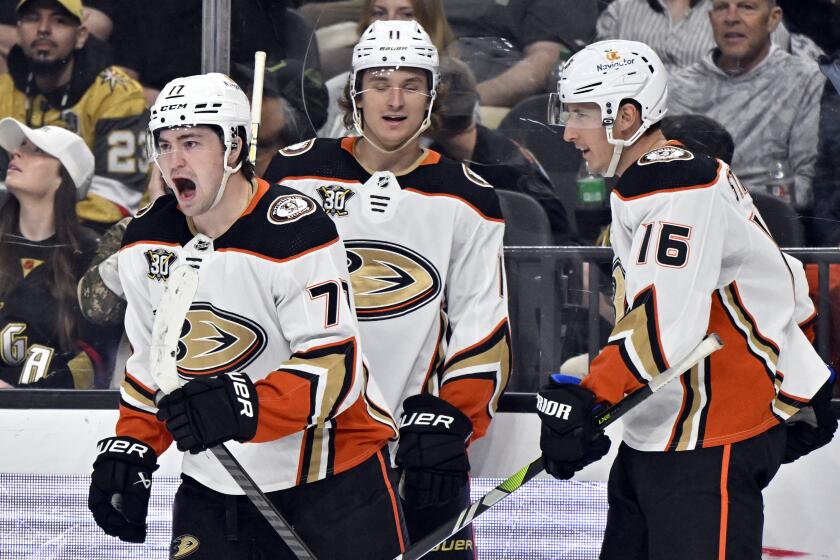For a hockey ‘enforcer,’ it pays to be brutal
There might be blood.
At the very least, there will be violence — George Parros can picture it in his mind.
The veteran hockey player goes looking for trouble, chasing down an opponent, then letting his gloves fall to the ice. It is an invitation to fight.
From there, the strategy is simple: Grab hold of the guy’s jersey with one hand and throw punches with the other, rapid-fire, aiming for the head.
“Everyone has a plan until they get hit,” he says. “So you don’t want to go in thinking too much.”
Parros is the designated “enforcer” for the Anaheim Ducks. Most NHL teams keep one on the roster, a player responsible for intimidating the other side with bare knuckles.
The game’s folklore holds a special place for goons — Stu “The Grim Reaper” Grimson, Dave “Tiger” Williams, the Broad Street Bullies — men of brute force if not always a full set of teeth. Parros has joined their ranks with 111 fights in his first six seasons.
This distinct skill set earns him $875,000 a year, not to mention a cult of fans who attend games at the Honda Center eager for a scuffle.
“Georgie’s been around,” teammate Ryan Getzlaf says. “He can handle the physical stuff.”
Parros certainly looks the part — 6-foot-5 and broad-shouldered with a villain’s black mustache — but anyone who considers him a mere thug would be mistaken.
With an Ivy League degree in economics, he might otherwise be working on Wall Street. His wife describes him as a homebody, a 30-year-old man who spends free time doing crossword puzzles and watching reality TV shows.
Parros says: “I’m not really that aggressive off the ice.”
It turns out his job can be equally deceiving. In the locker room after practice, peeling off pads one layer at a time, he explains that hockey fights are more complex than just pushing and shoving.
--
The kid was big and physical, but he never fought. Rising through the ranks of junior hockey in New Jersey, Parros focused on the game’s finer elements.
As his wife, Tiffany, likes to joke: “I knew George when he was a goal scorer.”
They met as teenagers, Parros playing alongside her brother.
“He was that kid who always did what he was supposed to do,” she recalls. “Always in a good mood.”
Parros’ outlook on hockey changed after four years at Princeton in the early 2000s. Though he ranked among the team’s best offensive players, his skills were not strong enough for the NHL, and any hopes of reaching the big time would require an alternate strategy.
At a pro development camp, he fought with a fellow prospect and held his own.
“It got me thinking,” he says. “Maybe I should add this to my tool belt.”
YouTube offered plenty of fights to study. He gathered tips from established enforcers, then supplemented his training with work in the boxing ring.
“It helps to get used to having punches come at your head,” he says. “It makes you less skittish.”
The NHL’s other Southern California franchise — the Los Angeles Kings, who once employed Williams, the all-time leader in penalty minutes — drafted Parros and sent him to the minor leagues where, during his first full season, he fought often enough to spend 126 minutes in the penalty box over the course of 57 games.
Hostility became a career move.
--
For all the hockey fights that erupt spontaneously, sparked by passions in a contact sport, there are just as many waged for tactical reasons.
“It’s one of those things you have to learn,” Parros says. “The ins and outs.”
Sometimes, the need for force is obvious — if the other guys rough up one of his team’s stars, the goon must exact revenge. Other situations are less clear-cut.
If the enforcer’s team is playing sluggishly, he might try to swing momentum by waking up the crowd. Same thing if the opposition pulls too far ahead. A hard check might suffice, or something more might be required.
Consider a game this season when the Ducks fell behind early against the Atlanta Thrashers and Parros began playing rough with one of the opposing stars, Dustin Byfuglien. Though Byfuglien is large, he stepped aside for teammate Chris Thorburn, a fledgling enforcer, to pick up the action. A fight ensued.
Parros and Thorburn grabbed hold of each other, tugging and pushing, throwing a few ineffective punches. They ultimately tumbled to the ice as officials moved in.
“Thorburn had my arms tied up pretty good,” Parros says. “I’m not sure how interested he was in fighting.”
Critics don’t like the idea of players squaring off in hockey. The very service Parros provides would get him ejected or even suspended if he were in the NBA or NFL.
But in the NHL, where grown men race around an enclosed space, constantly smacking into one another, some people consider fighting inevitable. They see enforcers as a deterrent; smaller skill players won’t get picked on if opponents know there is a price to pay.
That is what Randy Carlyle, the Ducks coach, means when he says Parros has become “a physical presence that is respected around the league.”
--
That tussle between Parros and Thorburn was indicative — most fights end with the combatants merely untangling and skating off to serve their five-minute penalties.
But there is always the chance that someone will land a knockout blow, causing serious injury.
“I probably went into every fight I had scared to death,” says Grimson, who retired in 2002 after more than 200 brawls, according to hockeyfights.com.
“The other part is humiliation,” he says. “When you do something in front of 20,000 screaming fans, that last thing you want is to get your tail kicked.”
As Parros learned boxing moves and tactics, he also dealt with the emotional aspect of his job. Imagine arriving at work each day, knowing there is a 50-50 chance you will be trading punches.
During his early years in the pros, fighting proved easier if an opponent checked him hard or delivered a cheap shot. It was more difficult to manufacture anger when strategy dictated a confrontation.
“If there’s a time in the game where a fight is coming up and you have to think about it, obviously a lot of thoughts go through your mind,” he says. “That’s always tough.”
There was at least one way to ease the tension.
“I liked to get the fight out of the way early in the game,” he says. “So I didn’t have to think about it.”
The Kings brought him up to the NHL in 2005, and he fought about once every three games. There was a brief stint with the Colorado Avalanche before the Ducks acquired him in 2006.
With each 82-game season, the right winger grew more comfortable in his role, getting six or seven minutes on the ice a night. He enjoyed the roar of the crowd and his teammates on the bench banging their sticks in approval after each scrap.
“Sometimes it can be cathartic,” he says. “It’s certainly thrilling if you have a good fight and the fans appreciate it.”
--
The Ducks were playing at Philadelphia in the winter of 2008 when Parros squared off against the Flyers’ enforcer, Riley Cote, unleashing an uppercut that put Cote flat on his back.
The knockout became an Internet favorite and boosted Parros’ reputation. Still, he would rather not talk about it.
“You have respect for the other guy,” he says.
This respect translates into an unwritten code of behavior.
Before the gloves drop, a subtle communication takes place — a tap on the shoulder, a few words — the instigator asking for a fight. The other player is free to decline. Most enforcers hate to say “no” but must consider the circumstances. Parros recalls a night in Detroit when he accepted an invitation and did not fare so well.
“That got their team going,” he says. “We ended up losing the game.”
Once a tussle starts, etiquette frowns upon hitting a man who is down. Gloating after a victory is similarly discouraged. Such decorum helps nurture an unexpected camaraderie among enforcers.
Two months ago, Parros and Kevin Westgarth of the Kings fought during a preseason game at Staples Center. The Princeton grads — Westgarth came along after Parros graduated — met for dinner with friends the next evening.
Something about hockey culture allows enforcers to compartmentalize their work. Westgarth, who lost a tooth to a stiff punch, calls it the “height of civility” because there are no hard feelings.
“You see yourself in the other guy,” he says. “You’re in the same boat.”
The young player adds: “That doesn’t mean you’re going to hit them any less hard.”
--
Sometimes Parros thinks about his college classmates and imagines a different sort of life. Working behind a desk. Crunching numbers. Getting his hockey fix at the local rink on Sunday afternoons.
“If I were playing in a men’s league,” he muses, “I wouldn’t be fighting.”
Not that he would trade places.
Life in the NHL not only pays well but also buys him time. Time to improve his stick handling and skating. Time to chase the dream of every enforcer who wants to be known for more than just fisticuffs.
His coach says he is headed in the right direction, becoming more confident with the puck, more dependable on defense. Yet, for now, fighting remains his meal ticket. When Parros and Tiffany talk on the phone before road games, she reminds him to “kick some butt.”
After so many confrontations, so many clenched fists, he has learned the nuances of this odd livelihood. Aggression comes more naturally.
“What kind of fighter am I?” he asks. “Willing. Eager.”
The kind who no longer feels so anxious before games. The kind who knows there will be grabbing and scuffling and punches.
Maybe even blood.
twitter.com/LATimesWharton
More to Read
Go beyond the scoreboard
Get the latest on L.A.'s teams in the daily Sports Report newsletter.
You may occasionally receive promotional content from the Los Angeles Times.







